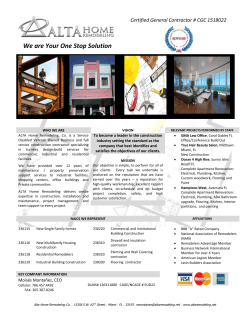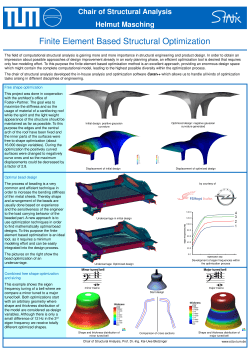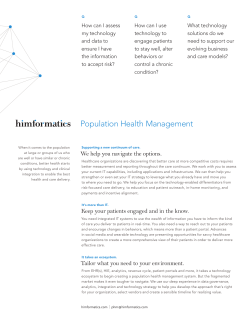
Upstream optimization: How continuous improvement
NEW PATHS TO PROFIT/ABILITYTM Oil and Gas May 2015 Upstream optimization: How continuous improvement methods are having a positive impact on production reliability and driving down cost Jorge Mastellari and CJ Renegar The experiences of four energy industry companies show how continuous improvement techniques can produce measureable benefits, including improved on-time work order completion, cost savings, increased productivity, inventory reductions, and improved process effectiveness. Key takeaways Continuous improvement can help energy companies temper the effects of market downturns and position them to perform even better in favorable markets. Continuous improvement involves all levels of employees working together to streamline work and reduce waste. Companies using continuous improvement achieved a measurable benefits in many different steps of their value stream. Continuous improvement helps identify inefficiencies or pain points and develop high impact and fast improvements. For the energy industry, swings in supply and demand are a normal part of doing business. Understandably, in times of low prices many companies look to cut costs and increase efficiency. As companies look to make those improvements, many successfully apply continuous improvement methods to save money and eliminate waste. But, while continuous improvement can be quite useful when plummeting prices focus management attention on cost savings, this methodology is essential to energy companies looking to grow and sustain a cost management discipline throughout the complete supply-anddemand cycle. Continuous improvement, a process for relentless waste elimination, involves all levels of employees working together to streamline work and reduce non-value-added activities and evolves constantly to proactively address broad marketplace conditions as well as individual steps in the production process. Continuous improvement has long been an essential part of the Lean1 toolkit, but in our experience it has not been as effectively and consistently applied in the oil and gas industry as it could be, thus not achieving the impact experienced in other industries. We believe that applying continuous improvement techniques could not only help energy companies temper the 1 Lean is a method focused on ongoing efforts to eliminate waste and activities that don’t add value from design, manufacturing, distribution, and customer service processes. 2 Upstream optimization effects of market downturns but also position them to perform even better when more favorable market conditions return. Against that backdrop, we offer four examples of energy companies that have employed continuous improvement methods to address various performance issues and the benefits they realized by doing so. By employing aspects of continuous improvement to various activities, these four companies achieved measureable benefits in areas such as on-time work order completion, cost savings, improved productivity, inventory reductions, and improved process effectiveness. Improving results by increasing accountability through Leader Standard Work The challenge: The leader of a base-maintenance organization recognized that front-line managers’ roles and responsibilities were unclear and critical work-streams lacked accountability. Key performance indicators such as schedule compliance, work-order backlog, and overall labor cost were falling short of the mark and trending downward. A continuous improvement team engaged by the leader to assess the organization’s daily duties and processes identified several areas of concern, including: • High-performance weeks happened by chance. There was little understanding of the reasons for the good performance, so the same results were difficult to repeat. • Front-line leaders spent only 10 to 20 percent of their time actively leading at the work site. The remainder of their time was spent in their offices “fighting fires” or dealing with exception reports. • Many important tasks were executed inconsistently across similar roles with large variations in quality. • Work standards were not being adhered to or weren’t understood. With a high turnover rate, new supervisor development was inadequate. The action: To address the issues, the continuous improvement team organized halfday workshops with front-line managers taking a Leader Standard Work approach— essentially the creation of checklists of leadership activities to be conducted on a regular basis. During the workshops, the managers examined their daily and weekly tasks to identify those that were critical to meeting objectives. The managers then used that information to build their own “K Cards,” standard work cards on which they scheduled essential daily tasks, with an emphasis on spending as much time in the field or shop as possible and aligning the supervisor’s schedule with production 3 Upstream optimization schedules, union breaks, and important meetings. A visual management board was designed and placed at the maintenance leaders’ office to track KPIs, match periodic managers’ activities with improvements, and peer-audit completion of tasks on K-cards. The results: The company’s supervisors now spend On-time work order completion improved by 20% in just 90 days. 60% And new supervisors now learn daily routines and what is expected of them in days Contractor productivity increased by 15% of their time in the field compared with 20 percent earlier. in the same period. rather than weeks. Eliminating non-value added activities to achieve contractor cost reduction The challenge: A company leader at an oil sands site believed there might be costsaving opportunities in the operations associated with removing gypsum and ash from adjacent ponds and relocating or hauling the material to another facility or customer. A contractor was responsible for the operations and management of 50 subcontractors and their equipment, including road haulage trucks, 5 to 6 backhoes and front loaders, and 2 dragline excavators. The leader asked a continuous improvement team to assess the operations. The action: The team observed the process several times over the course of a week. The team also reviewed contracts, invoices, and daily operator logs; completed an end-to-end value stream map of the operation and identified process waste and constraints; and met with the customer receiving the gypsum and ash to identify delivery requirements. The continuous improvement team recommended several actions to the leader, and then the customer, contractor, and supplier met in a workshop to develop waste reduction methods. The assessment led to several process improvements. Among them: • Gypsum was hauled directly from the pond to the customer after two days instead of repositioning it to another on-site area. The change eliminated the need for six operators, a backhoe, and a front loader. 4 Upstream optimization Exhibit 1: Continuous improvement results in improved contractor cycle time Process before continuous improvement Process after continuous improvement Value added Cycle time = 3 hours Cycle time = 2 hours Non value added • The customer began providing weekly email orders and monthly forecasts specifying how much gypsum it would need. The information went to the supplier’s logistics coordinator, who determined if a contract was needed for the next 28-day cycle. As a result, operations were suspended for three months while the customer reduced excess inventory. • Contractor operations and contracts were combined to share resources across multiple ponds instead of relying on separate resources and contracts for each pond. The results: 40% reduction in direct costs 33% reduction in assets required by the contractor 33% reduction in customer lead time 70% reduction in inventory 5 Upstream optimization Using Overall Equipment Effectiveness to improve reliability and utilization The challenge: A process engineer saw management’s frustration with an oil extraction plant’s inability to meet monthly production targets. The operation suffered from the absence of any fact-based method of setting priorities for improvement efforts in the plant; in many cases, reports from maintenance, operations, and reliability were contradictory. Other issues included: • Multiple groups using their own data; • A lack of overall trust in other’s data; • Inconsistent availability calculations that were not categorized by asset or equipment; and • Information on other factors such as start-up time, maintenance waiting time, and lack of ore to extract was not captured. Exhibit 2: Overall Equipment Effectiveness methodology improves reliability and utilization Extraction plant: Downtime analysis Availability = 80% Performance = 82% Quality = 99% Overall equipment effectiveness = 65% Tonnes, hour Availability loss Actual operating time versus capacity = 80% Performance loss Actual throughput versus operating capacity = 82% Capacity Sch Mtce Un Sch Mtce Un Sch Process Operating capacity Mine losses Downstream losses Prod plan loss Actual production 6 Upstream optimization The action: Working with a continuous improvement team, the process engineer identified a way to track the overall process using Overall Equipment Effectiveness (OEE) methodology.2 They collected data through daily operation log sheets. After two months of collecting data, they presented their findings to the operations general manager. After several meetings they developed a new methodology and began setting priorities based on the analysis. Among the solutions implemented were: • Daily reporting of reasons for missed hourly targets; • Monthly A3 reports3 with charts showing top maintenance downtime areas and actions to mitigate the downtime; • Staging of maintenance supplies nearer conveyors to reduce downtime; and • Identification of three continuous improvement projects regarding reducing maintenance start-up time and improving crusher uptime. The results: After 90 days, a focus on key processes resulted in the extraction plant’s OEE score improving from 65% to 72% a considerable improvement in such a short period. 2 Overall Equipment Effectiveness (OEE) is a hierarchy of metrics used to determine how effectively a manufacturing operation is utilized. 3 Concise two-page reports that derive their name from the paper size. 7 Upstream optimization De-bottlenecking through end-to-end value stream mapping and optimization The challenge: The leadership team of an energy company’s upstream operation sought to increase daily output from its mine operations and extraction plants by getting them to work together more effectively and to reduce inefficiencies such as trucks waiting around for an opportunity to dump ore or crushers sitting idle while waiting for ore to arrive. The mining operations were charged with removing overburden and providing the proper ore quality to the extraction plants. Both areas faced challenges in terms of asset reliability and execution of scheduled maintenance. The action: The continuous improvement team facilitated two three-day workshops that brought together important participants in the mine and extraction operations. The group created an end-to-end value stream map that highlighted areas of opportunity. It also identified operations bottlenecks and constraints, including crusher downtime caused by clogging, the need to balance the mining workload between removing overburden and supplying ore to extraction, and the fact that key operators were working from different daily production targets. Among the solutions implemented as a result of the analysis were: • The root causes of the crusher’s clogging were identified and necessary modifications were made. Additional equipment was located at hoppers to break up large pieces of ore. • Daily and weekly plans by hour are now shared directly with all control room operators and mine dispatchers. • Surge piles were created or improved to stage ore during shift changes or lunch times. • The quality of remote cameras was improved to show the actual size of surge piles. • Visual management boards detailing critical process data and scheduling sequences were installed near work areas. • Daily Gemba4 sessions—visits to worksites to view processes in action—were started. 4 Gemba walks involve management visiting an operation’s front lines—the place where value occurs—to look for examples of waste and opportunities to make shop floor improvements. 8 Upstream optimization The results: The operation realized a +5% increase in daily production after just 30 days Continuous improvement: Delivering better performance in any market conditions As the case studies demonstrate, continuous improvement is a powerful strategy to help companies overcome a variety of business process issues. By providing a framework for observing processes, gathering information, and analyzing that data, continuous improvement offers a mechanism for not only identifying the inefficiencies or pain points but also for designing and acting on the improvements necessary to address them. Improving processes and eliminating inefficiencies is critical in a down market, but for companies truly committed to empowering and sustaining a culture of “high performance” under any market conditions, continuous improvement can offer a powerful and genuine source of of competitive advantage. About the authors Jorge Mastellari, Senior VP, leads Argo’s Chemical and Oil and Gas practice. His international projects focus on EBITDA and cash flow improvement, product portfolio and profitability analysis, and the design and delivery of strategy deployment programs. CJ Renegar focuses on continuous improvement projects in the oil and gas, manufacturing, and transportation industries. Copyright © 2015 Argo, Inc. All rights reserved. Photography: © Shutterstock.com/Kawinnings
© Copyright 2025











